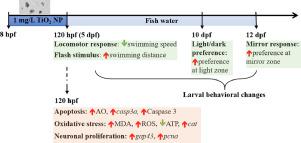Aquatic Toxicology ( IF 4.1 ) Pub Date : 2021-10-08 , DOI: 10.1016/j.aquatox.2021.105990 Jiangfei Chen 1 , Lei Lei 1 , Wen Mo 2 , Haojia Dong 1 , Jiani Li 1 , Chenglian Bai 1 , Kaiyu Huang 3 , Lisa Truong 4 , Robyn L Tanguay 4 , Qiaoxiang Dong 5 , Changjiang Huang 1

|
The widespread commercial application of titanium dioxide nanoparticles (TiO2 NPs) leads to ubiquitous presence of TiO2 NPs in the aquatic environment, which highlights the necessity to determine their potential adverse effects on aquatic organisms. The developing nerve system is particularly susceptible to environment perturbation. However, few studies have explored the developmental neurobehavioral toxicity of TiO2 NPs, especially at smaller particle size ranges (≤ 20 nm) that have relatively longer retention time in the water column. In this study, zebrafish embryos were exposed to non-teratogenic concentrations of 0.1 and 1 mg/L TiO2 NPs (average size of 14-20 nm) from 8 to 108 hours post-fertilization (hpf) followed by various assessments at different time points up to 12 days post-fertilization (dpf). Our findings revealed that 1 mg/L TiO2 NPs perturbed the motor and social behaviors in larval zebrafish. These behavioral changes were characterized by decreased swimming speed in a locomotor response test at 5 dpf, increased travel distance in a flash stimulus test at 5 dpf, increased preference to the light zone in a light/dark preference test at 10 dpf, and increased mirror attack and percent time spent in the mirror zone in a mirror stimulus response assay at 12 dpf. Mechanistic examinations at 5 dpf revealed elevated cell apoptosis and oxidative stress. Cell apoptosis was characterized by increased acridine orange (AO) positive cells in the olfactory region and neuromasts of the lateral line system. Oxidative stress was characterized by increased lipid peroxidation, increased ROS production, and upregulated catalase (cat) gene expression. In addition, TiO2 NP exposure also upregulated genes associated with the developmental nervous system such as the growth associated protein 43 (gap43) and proliferating cell nuclear antigen (pcna). Our results suggest that the neurobehavioral changes in larvae exposed to 1 mg/L TiO2 NPs during early development may result from cell apoptosis and oxidative stress induced neuronal damages.
中文翻译:

发育中的二氧化钛纳米颗粒暴露诱导斑马鱼的氧化应激和神经行为变化
二氧化钛纳米粒子 (TiO 2 NPs)的广泛商业应用导致 TiO 2 NPs 在水生环境中普遍存在,这凸显了确定它们对水生生物潜在不利影响的必要性。发育中的神经系统特别容易受到环境扰动的影响。然而,很少有研究探讨 TiO 2 NPs的发育神经行为毒性,特别是在较小的粒径范围 (≤ 20 nm) 中,在水柱中具有相对较长的保留时间。在这项研究中,斑马鱼胚胎暴露于 0.1 和 1 毫克/升 TiO 2 的非致畸浓度受精后 8 至 108 小时 (hpf) 的 NP(平均大小为 14-20 nm),然后在不同时间点进行各种评估,直至受精后 12 天 (dpf)。我们的研究结果表明,1 mg/L TiO 2NPs 扰乱了斑马鱼幼虫的运动和社会行为。这些行为变化的特点是在 5 dpf 的运动反应测试中游泳速度降低,在 5 dpf 的闪光刺激测试中移动距离增加,在 10 dpf 的明/暗偏好测试中对光区的偏好增加,以及镜子增加在 12 dpf 的镜像刺激响应测定中,在镜像区域中花费的攻击和百分比时间。5 dpf 的机械检查显示细胞凋亡和氧化应激升高。细胞凋亡的特征是嗅觉区和侧线系统神经瘤中吖啶橙 (AO) 阳性细胞增加。氧化应激的特征是脂质过氧化增加、ROS 产生增加和过氧化氢酶上调(猫) 基因表达。此外,TiO 2 NP 暴露还上调了与发育神经系统相关的基因,例如生长相关蛋白 43 ( gap43 ) 和增殖细胞核抗原 ( pcna )。我们的研究结果表明,幼虫在早期发育过程中暴露于 1 mg/L TiO 2 NPs的神经行为变化可能是由细胞凋亡和氧化应激诱导的神经元损伤引起的。











































 京公网安备 11010802027423号
京公网安备 11010802027423号